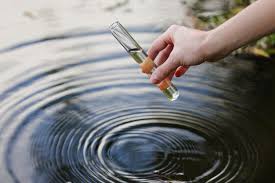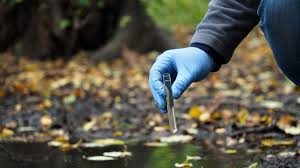What is the best way to test the purity of a water sample?
Assuming that you are talking about quality of drinking water, It is not quite possible to check microbiological and chemical quality of water at home. You can check the pH of water at home using pH strips or pH indicator which you can get from a chemical store. The ideal pH of drinking water is 7.0 to 8.5
For checking the Total dissolved solids in water, you can use TDS meter, which you should be able to find in a laboratory store. Or you can take a particular volume of water sample in a pre-weighed dish and boil the water to complete evaporation, cool the dish and weigh it again and calculate the mg of solids left behind per litre. This will give you TDS of your water. A good quality water should have TDS of 30–300 ppm in my opinion.
For determining the mineral content like Ca, Mg, Sulphate Chloride etc, you need lab equipment and particular chemicals. If you can get access to those, you can follow methods given by BIS which you can find online
If you don’t have access to a laboratory, you can contact a NABL accredited lab in or near your city and send around 8 litres of water sample (or as advised by lab officials depending upon which parameters of water quality you are interested in. The NABL accredited labs are where all the food industries send their samples to, to get them tested, so you can rely upon their results. These labs can do testing of your sample for all the microbiological and chemical parameters of concern and send you the reports.

What type of home mold test should I use?
Home mold tests are cheap, easy to use, available at most hardware stores, and almost entirely useless. So the answer is none. You should use none of them.
A standard home mold test typically consists of a petri dish that you allow to sit in your home, along with a substance to create mold growth inside (usually something called potato dextrose). You leave the test out for a specified amount of time, and then you cap the petri dish and let it incubate for a specified amount of time. These times vary by brand, so follow the manufacturer’s guidelines. If mold grows, you have mold. If it doesn’t—well, you get the point.
Spoiler alert: there is mold in your air. Mold spores are in the air just about anywhere you could go, including inside your home. Testing for the presence of mold is like testing for the presence of air. It is there, we promise.
There are two critical questions to answer regarding mold in your home, and whether or not it is there at all is not one of them. The first is whether the amount of airborne mold spores found in your home is excessive. Since there is no official guideline from the EPA on how much mold is too much, this is usually done by comparing the concentration of mold spores floating in your home to the concentration of mold spores floating outside. It’s also a task for a professional.
You should schedule one of these tests if you believe for any reason you may have a mold issue but aren’t sure since you haven’t seen any. Often times, there is a musty smell that is the calling card of larger than average amounts of mold. If you find that you’re coughing or sneezing more than usual, that may be a sign of high mold concentration in your home as well.

What is Water Pollution?
The water they say is life, and indeed they were right. About 70% of the earth is water, which has undeniably become one of our greatest resources. When we were young, we learned about the various ways to conserve water because water is used in almost every important human chores and processes. Water is an essential element in both domestic as well as industrial purposes.
However, a closer inspection of our water resources today gives us a terrible shock. Water is now infested with various wastes ranging from floating plastic bags to chemical waste, converting our water bodies into a pool of poison.
Water pollution is an appalling problem, powerful enough to lead the world on a path of destruction. Water is a natural solvent, enabling most pollutants to dissolve in it easily and contaminate it.
The effect of water pollution is directly suffered by the organisms and vegetation that survive in water, including amphibians. On a human level, several people die each day due to the consumption of polluted and infected water

How to Test for Bacteria on Kitchen Counters
Some nasty bugs may lurk on your kitchen counters, in your kitchen drains and even inside your refrigerator. E. Coli and salmonella, two common types of bacteria found in beef and chicken, cause intense gastrointestinal discomfort, and even death if left untreated. Finding out if these unwelcome guests have taken up residence in your kitchen is the first step to being rid of them. Home testing for bacteria is simple and affordable, and doesn’t require advanced scientific knowledge.
Step 1
Prepare a small sample of agar in the petri dish as directed on its package. Agar is a gelatinous substance used in cooking that also serves as a growth medium suitable for science experiments. Refrigerate your sample upside down for the specified amount of time.
Step 2
Use a sterile swab to take your samples.
Rub a sterile swab over the areas of your counter most prone to collecting bacteria. Check a variety of different areas, focusing on where you most often handle your food. For example, you can collect samples from the edges of the sink, as well as the back of your spice rack and the bottom of your knife block. Use a light touch, but make full contact with the surface.
Step 3
Rub the swab containing your sample onto the prepared agar and close the petri dish.
Step 4
Place your petri dishes in an out-of-the way spot, out of direct light. It will take three to seven days for growth to appear.
Step 5
Examine your petri dishes as growth begins to appear. While determining the types of fungi and bacteria found must be left to the professionals, you can easily identify bacteria as small white and yellow spots that multiply quickly, and fungi as larger, colorful, furry areas. The more spots, the higher your bacterial count.
Physical parameters of water quality /Physical characteristic of water
These are some physical aspects of water quality that helps to determine whether water is polluted or not.
1. Color:
- Pure water is colorless. Therefore any types of color appearance in water indicates water pollution.
- Natural water system is often colored by foreign material. If color is due to suspended material, it is called as apparent color. Color given by dissolved material that remains even after removal of suspended material is called true color or real color.
- The guideline value (maximum acceptable level) for color of drinking water is 15 TCU (True color unit).
2. Turbidity:
- Pure water is clear and do not absorb light. Therefore if turbidity appears in water, it indicates water pollution.
- Turbidity in water is given by various materials like suspended solid, dissolved materials and microbial loads. In general turbidity increases with increases in quantity of these materials in water. However different materials differ in their light absorption capacity.
- Some materials that give turbidity may be toxic to consumers. Therefore turbid water is not suitable for drinking purposes. Furthermore turbidity decrease efficiency of disinfection process.
- Materials that give turbidity provide attachment site for toxic chemicals.
- Turbidity prevents penetration of light into deeper layer of natural water system that directly affects photosynthetic organism in bottom.
- Drinking water should have turbidity less than 5 NTU (Naphthalometric turbidity unit)
3. Taste and odor:
- Pure water is always tasteless and odorless. Therefore if any types of taste and odor is present, it indicates water pollution.
- Water taste and odor may develops due to natural or artificial regions.
- Artificial region for taste and odor in water is due to disinfection process (chlorination). Some natural impurities dissolved in water can also give taste and odor.
- Inorganic salts such as NaCl, KCl etc dissolve in water give taste whereas compounds like H2S can give both taste and odor.
- Compounds giving taste and odor to water may be toxic to consumer, so drinking water should be taste less and odor less.
4. Temperature:
- Temperature is not directly used to evaluate whether water is potable (drinkable) or not.
- In natural water system like lake and river, temperature is very important physical factor that determines water quality. If temperature increase, solubility of Oxygen in water decreases.
- Furthermore rise in temperature increases the growth rate of aquatic microorganism, so they consume dissolved O2 faster and level of dissolved O2 decreases.
- Similarly, temperature affects disinfection process because efficiency of disinfection is lower at lower temperature.
5. Foam:
- Foam in water id due to foaming substances like detergents, soaps etc dissolve in water. Foam is regarded as dangerous in natural water system because it creates anaerobic condition.
- Some foaming substance is toxic to consumers. Therefore water with foam is not suitable for drinking purposes.
6. Conductivity:
- Conductivity of water is mainly due to presence of ionizable inorganic compounds.
- Pure water has very low conductance. For example 1µ mho for distilled water. Therefore conductivity measurement indicates amount of ionizable inorganic compounds in water.
7. Total dissolved solid:
- If water is filtered to remove suspended solid, the remaining solid in water indicates total dissolved solid.
- Dissolved solid may be organic (animal or plants waste) or inorganic compounds (carbonate, sulfate, bicarbonate etc). These compounds give variety of effects like hardness, taste, odor etc depending on nature of dissolved solid.
- If the dissolved solid in water exceeds 300 mg/ltr, it adversely affects living organisms as well as industrial products.